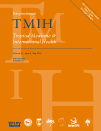Child diarrhea and nutritional status in rural Rwanda: a cross-sectional study to explore contributing environmental and demographic factors
Objective
To explore associations of environmental and demographic factors with diarrhoea and nutritional status among children in Rusizi district, Rwanda.
Methods
We obtained cross-sectional data from 8,847 households in May–August 2013 from a baseline survey conducted for an evaluation of an integrated health intervention. We collected data on diarrhoea, water quality, and environmental and demographic factors from households with children <5, and anthropometry from children <2. We conducted log-binomial regression using diarrhoea, stunting and wasting as dependent variables.
Results
Among children <5, 8.7% reported diarrhoea in the previous 7 days. Among children <2, stunting prevalence was 34.9% and wasting prevalence was 2.1%. Drinking water treatment (any method) was inversely associated with caregiver-reported diarrhoea in the previous seven days (PR=0.79, 95% CI: 0.68-0.91). Improved source of drinking water (PR=0.80, 95% CI:0.73-0.87), appropriate treatment of drinking water (PR=0.88, 95% CI:0.80-0.96), improved sanitation facility (PR=0.90, 95% CI:0.82-0.97), and complete structure (having walls, floor, and roof) of the sanitation facility (PR=0.65, 95% CI:0.50-0.84) were inversely associated with stunting. None of the exposure variables were associated with wasting. A microbiological indicator of water quality was not associated with diarrhoea or stunting.
Conclusions
Our findings suggest that in Rusizi district, appropriate treatment of drinking water may be an important factor in diarrhoea in children <5, while improved source and appropriate treatment of drinking water as well as improved type and structure of sanitation facility may be important for linear growth in children <2. We did not detect an association with water quality.
